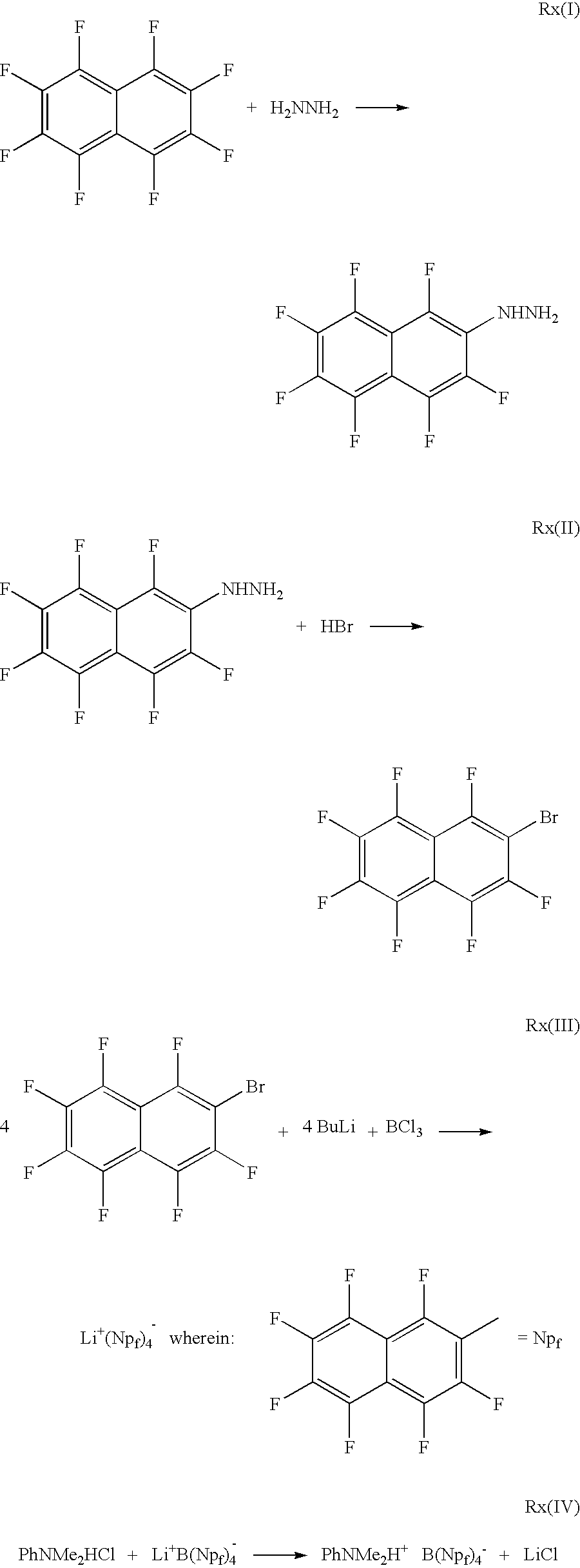Processes for the preparation of tetrakis(Faryl)borate salts
a technology of faryl borate and tetrakis, which is applied in the field of preparation of faryl borate salts and faryl borate salts, can solve the problems that none of the reported procedures are suitable for making faryl borates in high yields, and achieves reasonable reaction time, lessens the probability of localized powerful exotherm, and improves the selectivity of the desired mono-hydrazine substituted (faryl compounds
- Summary
- Abstract
- Description
- Claims
- Application Information
AI Technical Summary
Benefits of technology
Problems solved by technology
Method used
Image
Examples
example 1
Preparation of Perfluoronaphthyl-2-hydrazine
[0028]Octafluoronaphthatene (OFN) (55.4 g, 0.204 mol) was dissolved in absolute EtOH (202 g) at 40° C. Hydrazine hydrate, 85% (43 g, 0.73 mol) was added over a period of 30 minutes. The OFN precipitated during the addition and re-dissolved as it reacted. The reaction progress was monitored by GC, and after 6 hr. a 94% conversion to the monohydrazine substitution product was observed. The reaction mixture was cooled to ambient temperature, and then 240 g of water was added. The product precipitated as a fine solid, which was filtered, washed with 200 g of 50% ethanol water and dried in vacuum for 10 hr. The product was a yellow solid (60.0 g) which assayed 73.5% by standard NMR analysis. The yield was 76%.
example 2
Octafluoronaphthalene to heptafluoronaphthyl-2-hydrazine
[0029]A jacketed glass reactor was charged with 568 g of ethanol and 168 g of octafluoronaphthalene (Lancaster, 97%) (163 g contained 0.599 mol). The solution was stirred at 40° C. while adding 155 ml (160 g) of 85% hydrazine hydrate (136 g neat basis, 2.72 mol) over 37 min, and keeping the temperature within the range of 40° C. to 4200. After 3.5 hours, a GC analysis of a sample showed 96% conversion to product. After the mixture was cooled to 19° C., 250 g of water was added which raised the temperature to 28° C. Then 1.5 kg of methylene chloride and 650 g of water were added. The mixture was agitated, settled, and the layers separated. The aqueous layer was extracted with 130 g of methylene chloride, and then the combined organic phases were washed with 1 kg of water. 19F NMR analysis of the organic phase using hexafluoro-p-xylene as internal standard showed that the 1783 g of product solution was 8.5 wt % naphthylhydrazine ...
example 3
Conversion of heptafluoronaphthyl-2-hydrazine to 2-bromoheptafluoronaphthalene
[0030]A glass reactor equipped with a paddle-stirrer, a thermometer, and a distillation head was charged with 781 g of 48% HBr, and 292 g of CuBr2; the mixture was heated to 45° C. with the heating jacket set at 50° C. 886 g (66.5 g neat basis) of the methylene chloride solution of heptafluoronaphthyl-2-hydrazine prepared in example 2 above was added to the mixture over a 90 mm period. During this time, the methylene chloride was continually being distilled off and collected. After the addition was completed, the addition funnel was rinsed with 50 ml of methylene chloride and the rinse was added to the mixture. The temperature of the reaction mixture was raised to 80° C. After 2.5 h, analysis of a sample of the reaction mixture by GC showed complete conversion of the heptafluoronaphthyl-2-hydrazine. The reaction mixture was cooled to 19° C. 825 g of water was added; the mixing in of water was exothermic an...
PUM
| Property | Measurement | Unit |
|---|---|---|
| temperature | aaaaa | aaaaa |
| temperature | aaaaa | aaaaa |
| boiling point | aaaaa | aaaaa |
Abstract
Description
Claims
Application Information
 Login to View More
Login to View More - R&D
- Intellectual Property
- Life Sciences
- Materials
- Tech Scout
- Unparalleled Data Quality
- Higher Quality Content
- 60% Fewer Hallucinations
Browse by: Latest US Patents, China's latest patents, Technical Efficacy Thesaurus, Application Domain, Technology Topic, Popular Technical Reports.
© 2025 PatSnap. All rights reserved.Legal|Privacy policy|Modern Slavery Act Transparency Statement|Sitemap|About US| Contact US: help@patsnap.com

